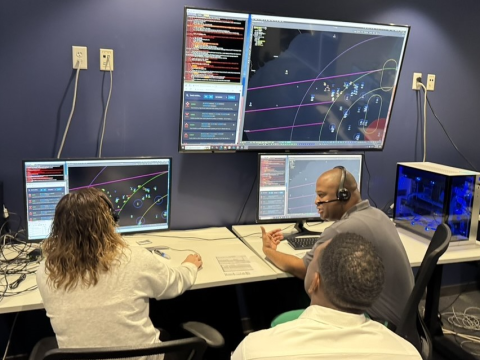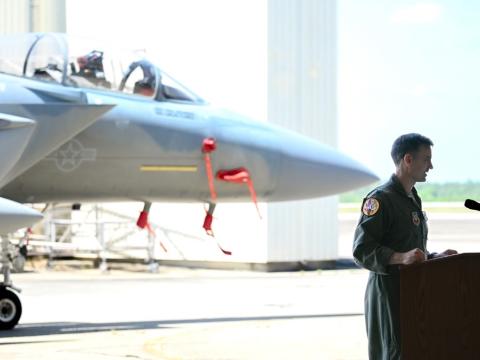Air Force Looks Retro For Aircraft Design
 |
| A micro unmanned aerial vehicle (UAV) designed by engineers at the U.S. Air Force Research Laboratory at Wright-Patterson Air Force Base, incorporates basic flight capabilities adapted from flying fauna and general aviation aircraft. Air Force researchers are pushing the limits of the principles of flight to design even smaller UAVs for a variety of missions. |
The next generation of unmanned aerial vehicles may owe more to winged insects and birds than to the Wright Brothers. U.S. Air Force engineers are tapping nature’s flyers for new designs that push the limits of aerodynamics.
For most of recent history, aerospace engineers worked to design aircraft that flew higher, faster, with greater payloads or a combination of the three. These factors defined pushing the art of aircraft design. Now, however, engineers at the Air Force Research Laboratory (AFRL) at Wright-Patterson Air Force Base, Ohio, are turning their attention away from those holy grails and instead are focusing on building slower, smaller aircraft. Their basic research aims at inventing a range of miniature unmanned aerial vehicles (UAVs) that could be small enough to fit in the palm of a human hand.
Achieving these goals will require surmounting engineering challenges never before faced in aerodynamic design—except in nature. So, these experts are trying to draw inspiration from bumblebees and hummingbirds, which already have proved the concept of miniaturized flight.
Michael Ol, aerospace engineer in the Air Vehicles Directorate at the AFRL, observes that this thrust toward smaller and slower presents challenges that have not been studied extensively over the past century of flight. Engineers are trying to develop aircraft that weigh only a few pounds but can fly at varied speeds or even hover. This effort has “flipped the table” on aerospace engineering, he notes, as scientists now must try to solve problems that were sidestepped as aviation soared to greater heights and speeds.
These new UAVs are a result of the high technology revolution that is shrinking component sizes while increasing capabilities. The Air Force is looking to build small vehicles that take advantage of tinier processing, antenna and battery technologies. Ol notes that there is no reason to build a large aircraft if it does not need to carry a human pilot and new technologies will permit construction of a smaller vehicle. Smaller aircraft that are unmanned are less expensive and are expendable.
Conceptually, the trend is away from enormous airports and support infrastructures and toward organic systems that move with the soldier, Ol offers. Similarly, small UAVs represent the decentralization theme that eschews the chain of precise instructions down the command structure. Small units or individual soldiers can deploy small UAVs to suit their needs, and their communications will improve as a result.
The laboratory is working with the warfighter community to determine which missions are the best candidates for the concept vehicles. This also touches on which payloads are best for the innovative small craft. Other directorates in the AFRL are working with Ol’s directorate on miniaturization issues, especially with components.
The entire effort is a spiral development process, he continues. “If we can demonstrate a level of capability that we’ve seen in hundred-pound airplanes—which already are pretty small UAVs and already have quite a set of challenges—or a slightly smaller level of capability with a one-pound airplane, then that would be a more feasible challenge to get our hands around at this point in time,” he states.
“We go to a smaller aircraft because we can; and once we do go to a smaller aircraft, then we have to figure out how to make that little plane fly as efficiently as a big plane,” Ol says.
So for this challenge, the Air Force looked to nature. The aerodynamics and propulsion of soaring birds, for example, are very different from those of existing aircraft. “They have solutions that we haven’t even looked at thoroughly in the past,” Ol states. “So, we’re trying to understand how to fly better when you’re small and when you’re slow.
“The bumblebee is the classic example of how to confuse an aerospace engineer,” Ol continues. “When you look at how big its wings are, how fast it flies and how much horsepower it generates, you decide that it can’t fly at all—and obviously, that’s not true. The reason that it can fly is that bumblebees have figured things out that we haven’t quite figured out yet.”
Ol adds that AFRL researchers are taking small steps toward that goal. Yet, many of the gains that they have achieved owe more to conventional aircraft design. He relates that engineers have been working to scale down large aircraft design to a smaller version. This work has focused on the physics of flight with a general aviation aircraft such as a Cessna. The scientists are bringing that type of aircraft down to increasingly smaller levels where they can maintain a flight envelope. Ol notes that these engineers have effectively reduced this general aviation aircraft to about one pound in weight. He describes this as a distant cousin of what consumers might buy in a hobby store, but much more generic.
However, this work is more complex than what is required to build a flying model aircraft, Ol points out. A model aircraft has a relatively simple mission—take off, fly and land safely. The Air Force is seeking UAVs that might have a much more elaborate set of missions that are not even fully defined yet. Even so, designers are trying to meet these missions’ requirements with a vehicle that is only slightly more complicated than the hobbyist’s aircraft.
The challenge is that, the smaller an aircraft becomes, the more difficult it is to have a rigorous engineering approach to understanding what it does, Ol declares. “What we are trying to do is to get as experienced and as knowledgeable about smaller airplanes as we have been about big airplanes. Eventually, hopefully, we will get down to the bumblebee size.”
The laboratory effectively is pursuing two parallel tracks. One is to scale down that Cessna to micro-UAV size without losing too much efficiency. The other track is to work toward developing a bumblebee- or dragonfly-type aircraft. This higher risk track is much less defined, Ol says. Its challenges involve basic research into fluid mechanics. Ultimately, the two tracks could converge in the not-too-distant future, he offers.
Understanding how air interacts with small wings, small propellers and small structures is a major technological hurdle, Ol states. “Just to get a one-pound airplane to fly as well as a 1,000-pound airplane represents a lot of challenges in basic aerodynamics,” he says.
Another challenge is system integration. Engineers must find a way to fit all the pieces together in a very small volume in an exceedingly light platform. “It’s one thing to have a collection of sensors, communication equipment, flight control equipment or other onboard systems in a fighter aircraft or bomber,” Ol says. “Imagine how much more challenging that would be if you scaled that down by a linear factor of a hundred—a cubic scale of a million. If it weighs a million times less, things are much harder to package, make reliable and communicate with over a distance.”
Long-range communications with a micro-UAV raises power issues. While a small vehicle with tiny subsystems may require only minimal power, its communications system will need the power necessary to achieve the desired range—which may be many miles—in the Earth’s atmosphere.
Powering these vehicles may prove to be the key to their performance. Batteries are at the heart of it, and while their technology has improved over the past few years, powering the UAV raises other issues. Ol offers that part of the challenge is to go from a battery to something that actually provides force for flight or hovering. This may require efficiencies in propellers or other technologies that have not yet been achieved.
The research team has encountered several surprises, foremost of which is “how smart nature is,” Ol offers. “When you look at a hummingbird and get down to studying what it does, how it is shaped, how it moves its wings, how it does what it does—it becomes amazing how it can manage the challenges of flying slowly and flying small,” he states. The aerodynamicists who are studying flying fauna are fascinated by how well airborne creatures can respond to quick wind gusts. A flying creature weighing only a few ounces that is hovering inches away from a plant theoretically should be blown away by a sudden burst of wind. However, these creatures manage to stay near their target, and engineers have been working to understand how they do it.
Some of the work can be called biomimetic, where engineers seek to mimic biological structure and function (SIGNAL, March 2000, page 37). Another description of these aerospace engineers’ work is biomorphic, where they follow the lead of nature without necessarily copying it. Ol notes that nature does not feature rotating machinery, but humans can engineer that capability into propellers or rotors. So, having some kind of rotating airfoil is not precluded in a micro-UAV just because it does not exist in the natural world.
However, designers selectively can take nature’s expertise in aerodynamic problem solving. Ol relates that some engineers are examining mechanical flapping wings for these small UAVs. Unlike their natural counterparts, however, these wings would not flap like a bird’s. They would move straight up and down both to provide propulsive force and to entrain airflow over the wing.
“What we are trying to do is to selectively take examples from nature that meet challenges that we know exist, but not to religiously copy nature just because it is fashionable to be biomimetic,” Ol declares.
One avian concept that designers are trying to emulate is the ability to perch. A manned aircraft cannot settle into a tree for observation, but a small UAV might be able to imitate birds by landing on a branch. “The concept of perching, as an engineering challenge for what an airplane can do, will be quite a feat,” Ol warrants.
The AFRL may team with industry and academia in its research, Ol states. The laboratory has not teamed with anyone yet, but it is keeping an eye on other organized activities. One company, Aerovironment, already has built two different micro-UAVs that weigh less than one pound.
The laboratory is keeping potential dual-use systems on its radar, Ol adds. For example, its perching UAVs might serve civil authorities in fighting forest fires over vast areas. A fleet of UAVs could perform coordinated patrols that send alarms when fires are detected.
The AFRL’s goal of producing its small UAVs is several years away, and several factors will influence its quest. Among the determinants is how officials will view these UAVs as part of their bigger picture of Air Force operations. If officials decide to push harder for these systems, then the laboratory may achieve its goals in just a few years, Ol offers.




Comments